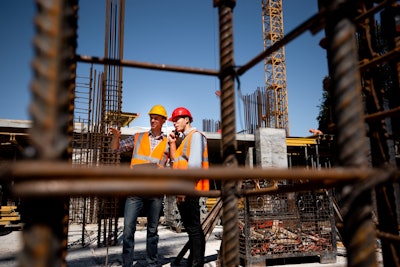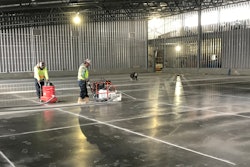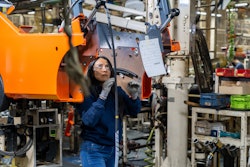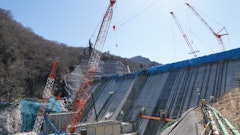
Construction spend is currently at an all-time high. Across the country, infrastructure is getting modernized, data centers are being built, and manufacturing facilities are being reshored.
There is, in fact, so much work that it’s hard to keep up. The boom in construction has meant that supply hasn’t been able to keep up with demand — materials prices are still 40% higher than in February 2020, we’re facing an acute worker shortage, projects are stuck in lengthy permitting processes, and many construction workers across the country still have to rely on pen, paper, and Excel to complete projects.
To ensure we can keep up with our construction needs in the U.S. and fix the state of our nation’s infrastructure, we need to both accelerate the adoption of technology and push for policy reform.
The Boom in Construction
The $1 trillion federal infrastructure bill, growing investment in green power infrastructure, rising U.S. consumer demand, and initiatives to reshore manufacturing have all contributed to tremendous growth in commercial construction.
As part of the infrastructure bill, $55 billion is dedicated to improving water quality across the U.S., $65 billion to improving broadband and telecom access, and $110 billion to improving roads and bridges. According to the White House, 40,000 new projects covering everything from airports to roads and electric vehicle charging stations have already been launched by the current administration.
When it comes to reshoring manufacturing, this is happening faster than we’ve seen in decades. As reflected in the surge of mentions in S&P 500 earnings transcripts, companies across all sectors of the economy have been rapidly moving production from former hubs such as China back to the U.S., contributing to a ‘"striking surge" in construction spending for manufacturing facilities.
Now, the question that’s top of mind for construction businesses across the U.S. is how to keep up with this level of demand.
The Problems: Construction Productivity Gap and Red Tape
Much has been written about the need to address the construction labor shortage in the U.S. The major problems that don't get as much coverage are the red tape currently slowing down progress on countless projects across the country and the persistent construction productivity gap.
According to McKinsey, the construction industry saw the slowest growth rate in terms of labor productivity of all sectors in the U.S. in the second half of the 21st century. Fast-forward to today and rework is estimated to cost the construction industry over $65 billion annually. Companies often report that vast amounts of time spent on manual data entry, poor estimating, and cost tracking cost them billions of dollars a year.
When it comes to red tape, outdated permitting and environmental review regulations cause huge delays for new projects. Studies required by the National Environmental Policy Act (NEPA) can run thousands of pages long. Identifying which permits are needed and who the appropriate issuing agencies are is laborious. Fighting local opposition takes years. Even clearing the interconnection queue to get plugged into America’s power grid took an average of five years for projects completed in 2022.
Our immigration policy makes it difficult for foreign, skilled workers who could help accelerate the pace of construction in the U.S. to obtain visas. Our underfunding of career and technical education means too many high school students don’t know about the opportunities within the construction industry, further exacerbating the industry’s recruitment challenges.
In many ways, we unnecessarily make it harder for ourselves to build.
The Solution: Adopting Technology
We can make every person working on a construction project today more productive using technology.
Using modern estimating programs, workers can easily use historical scope and cost data to create more accurate estimates. Bids can be put together faster and projects can be started more expediently.
Using materials management software, companies can make it easy for their teams to ensure they’re buying materials at the best price and getting them delivered when needed. Incorrect deliveries and unforeseen backorders can push project schedules back by months - technology can help prevent that.
Using tool tracking software, field, warehouse, and purchasing teams can ensure clear visibility into tools’ conditions, locations, and current assignees.
Using Optical Character Recognition technology, PDFs can be converted into text and mapped to accounting system fields in seconds. Using real-time image capture technology, companies can resolve disputes based on visual evidence and track job progress in real time. Using AI, searching through building codes and submittal documents can become instantaneous.
The new generation entering the construction industry grew up with computers in their pockets. In the same way that they can easily order groceries or a ride with the click of a button, they will increasingly expect it to be simple to order materials or run a cost model. By automating the most repetitive and least pleasant parts of people’s days, we can free up their time to focus on higher-value work.
Policy reform
Another part of the solution lies in policy reform.
With several years of near-gridlock in Congress behind us and an election looming ahead, you might laugh at me for suggesting that policy solutions could help; I didn’t become a U.S. citizen last year for nothing. I have always been and remain optimistic that policymakers can come together to solve challenges. Policy can help construction in a number of ways.
Immigration reform that makes it easier for foreign, skilled workers to obtain visas in the U.S. would go a long way. Increasing the cap on non-agricultural H-2B visas available would help directly address the labor shortage. Streamlining the visa application process by bringing it online would help speed up the approval process. Creating pre-certification programs for trusted employers would further reduce processing times. Increasing the dedicated support resources available to help employers and applicants would help resolve application issues faster.
Regarding educational reform, narrowing the funding gap between college-prep programs and career and technical education (CTE) should be a top priority. Increasing funding for CTE programs across high schools would allow more students to be exposed to the benefits of pursuing a career in construction. Bringing in local construction firms to partner with these programs and hosting construction-centric career fairs would allow us to showcase the variety of roles that exist in the industry and combat industry stereotypes. Funding apprenticeship programs such as Heavy Metal Summer Experience would make a huge difference in informing young and under-represented talent about the opportunities the construction industry has to offer.
When it comes to permitting and inspection processes, implementing online permitting systems, expediting approval timelines, and standardizing building codes and regulations would all enable construction projects to get built faster and more efficiently. Policies to set time limits on environmental reviews of major federal energy projects, streamline the NEPA review process, and accelerate the approval of the interstate electrical transmission lines needed to get more renewable energy to homes and businesses would all allow us to make progress faster.
The next 10 years can, and should, be a golden age for construction in the U.S. By accelerating the adoption of technology and policy reform, we can significantly increase the likelihood that they are.





















